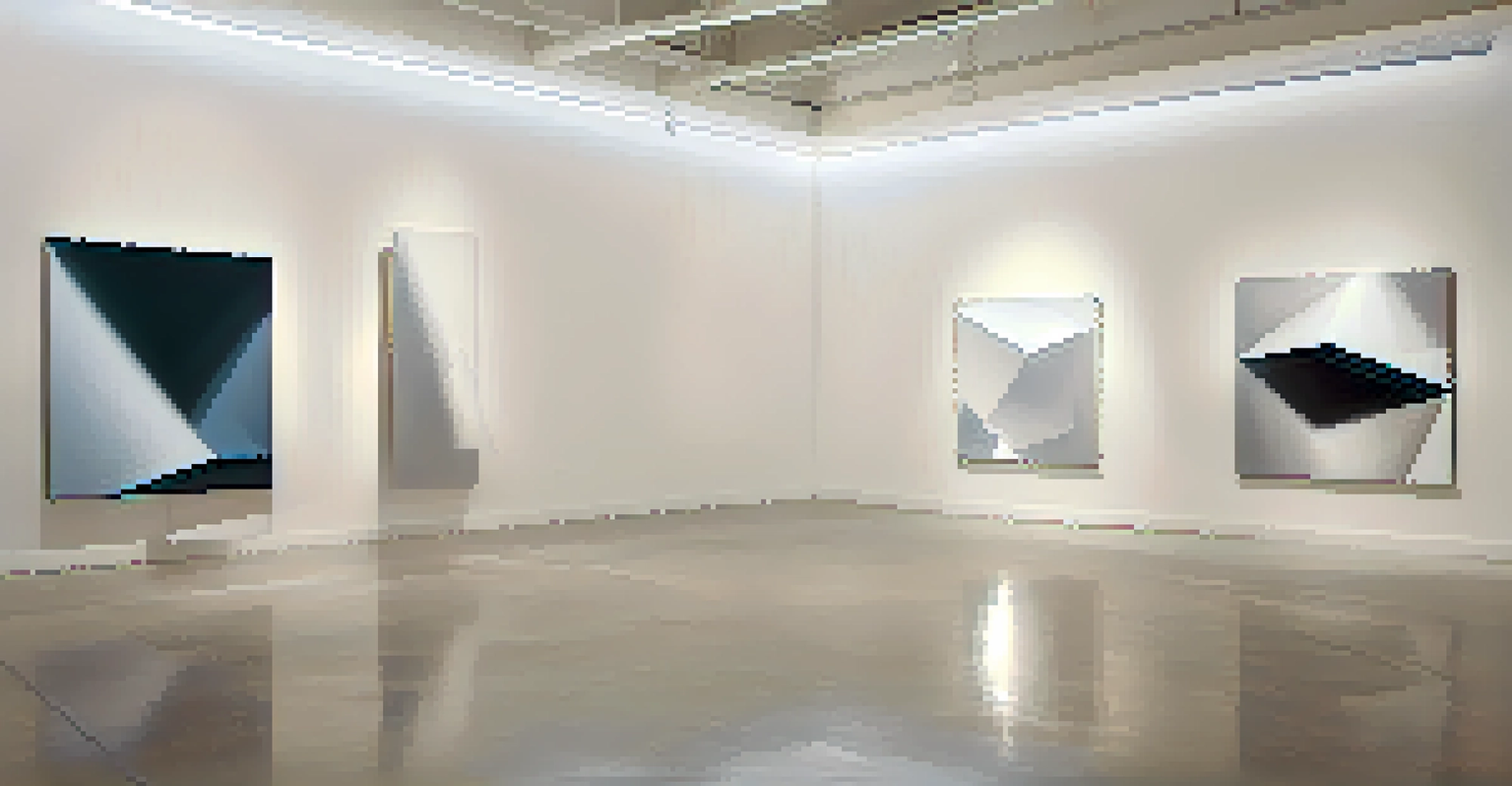Postmodern Perspectives: Shifting Paradigms in Art Evaluation

Understanding Postmodernism in Art Evaluation
Postmodernism marks a significant shift in how we evaluate art, moving away from the rigid standards of modernism. This perspective embraces pluralism, which means multiple interpretations and values can coexist. It challenges the idea of a single 'correct' way to understand art, inviting a broader audience to engage with diverse viewpoints. By focusing on context and subjective experience, postmodernism opens up new avenues for appreciation and critique.
Postmodernism is not a style; it is a condition of our society and a challenge to our ways of thinking about art, culture, and identity.
In postmodern art evaluation, the personal experience of the viewer becomes just as important as the artist's intention. This approach often leads to discussions about cultural background, societal influences, and the historical moment surrounding the artwork. For instance, a piece that might seem meaningless to one person could resonate deeply with another based on their unique life experiences. This democratization of art appreciation reflects a significant paradigm shift.
Related Resource
Moreover, postmodernism often incorporates irony and playfulness, further complicating traditional evaluation methods. Artists might intentionally blur the lines between high and low art, forcing us to reconsider preconceived notions about quality and value. An example is the rise of street art, which challenges the exclusivity of galleries and museums, making art accessible to the public. This shift encourages a more inclusive and dynamic art evaluation landscape.
The Role of Context in Art Interpretation
In the postmodern context, the setting in which art is created and displayed is crucial for interpretation. This perspective emphasizes that art does not exist in a vacuum; rather, it is deeply intertwined with cultural, social, and political factors. When assessing a piece, understanding its origin and the environment surrounding it allows for richer insights. For example, a painting reflecting a specific historical event can evoke different reactions based on the viewer's background.

Art critics and historians now often consider the artist's biography, societal influences, and the medium used as essential elements of evaluation. This broader lens helps decipher meaning and intention, illustrating how interconnected art is with various aspects of life. By examining these contexts, we can appreciate how art serves as a reflection of the times and the values of the society in which it was created.
Embracing Diverse Art Interpretations
Postmodernism promotes a pluralistic view of art, encouraging multiple interpretations and valuing personal experiences alongside the artist's intention.
Additionally, this contextual approach has led to a resurgence of interest in marginalized voices, previously overlooked in traditional evaluations. Artists from diverse backgrounds can provide fresh perspectives that enrich our understanding of art. This inclusion not only diversifies the art world but also promotes a more comprehensive evaluation process that recognizes the importance of different narratives.
Interactivity and Audience Engagement in Art
Postmodern art often invites viewer participation, breaking down the traditional barriers between artist and audience. This interactivity transforms the experience of art from passive observation to active engagement. For instance, interactive installations encourage visitors to contribute to the artwork, changing its meaning in real time. This shift highlights the evolving nature of art, as it becomes a collaborative experience rather than a solitary one.
Art is not freedom from discipline, but disciplined freedom.
As audiences engage with art, their reactions and interpretations become part of the artwork's identity. This phenomenon blurs the lines between creator and observer, fostering a sense of community and shared experience. For example, a community mural might change over time as locals add their own touches, making it a living piece of art that reflects collective identity. This communal approach enriches both the art and the evaluation process.
Related Resource
Furthermore, social media has amplified this trend, allowing for real-time feedback and discussions about art. Viewers can share their interpretations across platforms, contributing to a collective understanding of the piece. This dynamic exchange creates a more vibrant and inclusive art dialogue, where diverse opinions shape our appreciation and evaluation of art.
Irony and Parody in Postmodern Art
One defining characteristic of postmodern art is its use of irony and parody, which often challenges traditional artistic conventions. Artists might employ humor or absurdity to make statements about societal norms or artistic expectations. This playful approach not only entertains but also invites the audience to question the very nature of art itself. For example, Andy Warhol's work often satirizes consumer culture, prompting viewers to reflect on the relationship between art and commerce.
This use of irony can also serve as a critique of art institutions, highlighting the discrepancies between artistic value and market value. By drawing attention to these contradictions, postmodern artists encourage viewers to reconsider their assumptions about what constitutes 'high' or 'low' art. This shift in perspective is vital for a more nuanced evaluation of art in today's diverse landscape.
Context Shapes Art Evaluation
Understanding the cultural and historical context of an artwork enhances its interpretation and reflects the interconnectedness of art with society.
Consequently, irony and parody broaden the scope of art critique, making it more accessible and relatable. Viewers are invited to engage with art on a personal level, as they navigate the layers of meaning embedded within. This playful engagement fosters deeper discussions about art's role in society and its power to provoke thought and inspire change.
Decentralization of Artistic Authority
In the postmodern era, the notion of a singular artistic authority has been significantly challenged. Instead of relying solely on established critics or institutions, a multitude of voices now contribute to the evaluation of art. This decentralization empowers artists, critics, and audiences alike, allowing for diverse interpretations and critiques to flourish. For example, online platforms enable independent critics to share their insights, democratizing the art conversation.
This shift has resulted in a more pluralistic approach to art evaluation, where no single narrative dominates. Audiences can engage with various perspectives, enriching their understanding of art. This multiplicity of voices creates a vibrant discourse, allowing for a more comprehensive exploration of meaning and value in art. As a result, the evaluation process becomes a collaborative effort, reflecting the complexity of contemporary society.
Related Resource
Moreover, this decentralization encourages artists to experiment and take risks without the fear of conforming to traditional standards. They are free to explore unconventional ideas, fostering innovation in the art world. This creative freedom not only enriches artistic expression but also leads to fresh approaches in evaluation, as we learn to appreciate the diverse paths that art can take.
Challenging Traditional Notions of Aesthetic Value
Postmodernism invites us to rethink what we consider aesthetically valuable in art. Rather than adhering to classical standards of beauty or technique, this perspective promotes the idea that art can be valuable for its ideas, messages, or social commentary. This shift has led to the recognition of various forms of expression, including performance art and conceptual installations, which may not fit traditional definitions of beauty.
For instance, a piece that captures a poignant social issue may gain significance beyond its visual appeal. This approach encourages viewers to engage with the underlying message and context, rather than focusing solely on aesthetics. As a result, the evaluation process becomes more about the conversation surrounding the artwork than its mere appearance.
Decentralizing Art Authority
The rise of diverse voices in art evaluation challenges traditional authorities, fostering a collaborative approach that enriches the art discourse.
Additionally, this redefinition of aesthetic value opens doors for the appreciation of non-traditional art forms, such as digital art or community projects. These works may challenge our preconceived notions of what art can be, pushing the boundaries of creativity. By expanding our understanding of value, we embrace a more inclusive and dynamic evaluation landscape that reflects the complexities of contemporary artistic expression.
The Future of Art Evaluation in a Postmodern World
As we move further into a postmodern world, the evaluation of art will likely continue to evolve. The ongoing integration of technology and social media into art experiences will shape how we engage with and interpret art. This evolution presents both challenges and opportunities, as new platforms emerge to showcase diverse voices and perspectives. The future of art evaluation will be marked by an increasing emphasis on inclusivity and collaboration.
Additionally, as globalization continues to influence art, we can expect a richer tapestry of cultural expressions. This interconnectedness will prompt us to reevaluate our approach to art, encouraging cross-cultural dialogues and the sharing of diverse artistic practices. Such exchanges will deepen our understanding of art's role in various societies and broaden the criteria by which we evaluate it.

Ultimately, the future of art evaluation in a postmodern context invites us to remain open-minded and curious. As art continues to challenge our assumptions and inspire new ways of thinking, we must adapt our evaluation methods accordingly. Embracing this dynamic landscape will ensure that our appreciation of art remains relevant and reflective of the diverse world we inhabit.